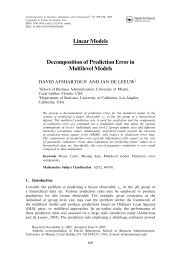Issues to Consider in the Design of Randomized Controlled Trials
Issues to Consider in the Design of Randomized Controlled Trials
Issues to Consider in the Design of Randomized Controlled Trials
- No tags were found...
Create successful ePaper yourself
Turn your PDF publications into a flip-book with our unique Google optimized e-Paper software.
<strong>Issues</strong> <strong>to</strong> <strong>Consider</strong> <strong>in</strong> <strong>the</strong> <strong>Design</strong> <strong>of</strong><strong>Randomized</strong> <strong>Controlled</strong> <strong>Trials</strong>Jay Wilk<strong>in</strong>son, MD, MPHPr<strong>of</strong>essor <strong>of</strong> Pediatrics & EpidemiologyMiller School <strong>of</strong> Medic<strong>in</strong>e
Sem<strong>in</strong>ar Purpose• To facilitate an <strong>in</strong>teractive discussionbetween presenter and audience regard<strong>in</strong>gissues relevant <strong>to</strong> <strong>the</strong> design <strong>of</strong> randomizedcontrolled trials• Please feel free <strong>to</strong> ask questions at any timedur<strong>in</strong>g or after <strong>the</strong> presentation• Presenter contact:jwilk<strong>in</strong>s@med.miami.edu
Learn<strong>in</strong>g Objectives• The rationale for randomization• The importance <strong>of</strong> statistical expertise<strong>in</strong> design<strong>in</strong>g, moni<strong>to</strong>r<strong>in</strong>g, and <strong>in</strong>terpret<strong>in</strong>g <strong>the</strong>study• Hypo<strong>the</strong>sis classification• Superiority vs. non-<strong>in</strong>feriority vs. equivalence trials• Controls
Learn<strong>in</strong>g Objectives• Simple vs. adaptive vs. restrictedrandomization• Bl<strong>in</strong>d<strong>in</strong>g and allocation concealment• DSMBs and s<strong>to</strong>pp<strong>in</strong>g rules• CONSORT• Explana<strong>to</strong>ry vs. <strong>in</strong>tention <strong>to</strong> treat analysis
<strong>Randomized</strong> <strong>Controlled</strong><strong>Trials</strong> (RCTs)• Gold standard• Difference from cohort (observational study)• Limitations• Sample size and study power• Meta-analysis
RCTs: Sources <strong>of</strong>Potential Bias• Biases• Selection bias• Information/observer bias• Loss <strong>to</strong> follow up- don’t know patien<strong>to</strong>utcome• Patient subjective reports• Patient exam<strong>in</strong>ations/evaluations• Patient surveys- behavioral studies• Social desirability/please <strong>in</strong>vestiga<strong>to</strong>rs
RCTs: Study <strong>Design</strong>Schematic
Statistical Expertise• Before start<strong>in</strong>g <strong>the</strong> RCT design• Have statistical and/or epidemiological partner• Will decide optimal sample size <strong>to</strong> maximize studypower• Will decide optimal randomization scheme• Will decide optimal allocation ratio• Will allow for establishment <strong>of</strong> s<strong>to</strong>pp<strong>in</strong>g rules• Will design <strong>the</strong> optimal analytic plan• Ensure compliance with CONSORT
RCTs: Hypo<strong>the</strong>sisClassification• Superiority• Experimental condition is superior <strong>to</strong> <strong>the</strong>control• Active control trials• Non-<strong>in</strong>feriority• Equivalence• Require larger sample sizes
Active Control <strong>Trials</strong>• The term active-control trial refers <strong>to</strong> all studies <strong>in</strong> which <strong>the</strong>control treatment is an active one.• If <strong>the</strong> <strong>in</strong>tent is <strong>to</strong> show that <strong>the</strong> differences between controland study treatments are not large <strong>in</strong> ei<strong>the</strong>r direction <strong>the</strong>study is called an equivalence trial.• If <strong>the</strong> <strong>in</strong>tent <strong>of</strong> a study is <strong>to</strong> demonstrate that <strong>the</strong> studytreatment is not substantially worse than than <strong>the</strong> controltreatment <strong>the</strong> study is called a non-<strong>in</strong>feriority trial.• Both types <strong>of</strong> trials seek <strong>to</strong> reject <strong>the</strong> possibility thatdifferences <strong>in</strong> treatment effects equal or exceed a preset limi<strong>to</strong>r marg<strong>in</strong>.
Control Groups• Placebo• Active treatment controls• Attention controls• No treatment
RCTs: Randomization• Cl<strong>in</strong>ical <strong>Trials</strong>- <strong>Design</strong>• Randomization:• Most effective means <strong>of</strong> <strong>of</strong> account<strong>in</strong>g forpotential confounders• Treatment groups should be equivalent atbasel<strong>in</strong>e if randomization successful• Also controls for selection bias
RCTs: RandomizationApproaches• Simple Randomization• Most <strong>of</strong>ten used• All subjects have equal probability <strong>of</strong> assignment <strong>to</strong> anytreatment condition• May lead <strong>to</strong> imbalance <strong>in</strong> condition assignments• Adaptive• Covariate adaptive• Stratified (blocked) vs. m<strong>in</strong>imization• Response adaptive (“play <strong>the</strong> w<strong>in</strong>ner”)• Treatment success <strong>in</strong>creases allocation <strong>to</strong> treatment
RCTs: RandomizationApproaches• Restricted randomization• Permuted block randomization• Adaptive biased-co<strong>in</strong> (urn)randomization
RCTs: Permuted BlockRandomization• 2 treatments (A or B); block size= 4• 6 permutations• Randomly select permutations• {AABB, ABAB, BAAB, BABA, BBAA, ABBA}ABAB BABA ......Pts 1 2 3 4 5 6 7 8 9 10 11 12• Vary block sizes and bl<strong>in</strong>d system <strong>to</strong> avoid selection bias
RCTs: Permuted BlockRandomization• To ensure balance between treatment groups,participants are allocated <strong>in</strong> blocks• Each block has equal numbers <strong>of</strong> treatment (A) andcontrol (B)• Order <strong>of</strong> treatments randomly permuted (rearranged) sothat all possible permutations are created• BLOCK SIZE 4: 6 possible permutations• BLOCK SIZE 6: 8 possible permutations
RCTs: Use <strong>of</strong> Bl<strong>in</strong>d<strong>in</strong>g• Cl<strong>in</strong>ical <strong>Trials</strong>- <strong>Design</strong>• Bl<strong>in</strong>d<strong>in</strong>g (Mask<strong>in</strong>g): effective at controll<strong>in</strong>g manyforms <strong>of</strong> potential bias• S<strong>in</strong>gle vs. double bl<strong>in</strong>d<strong>in</strong>g*• Decrease observation and report<strong>in</strong>g bias• Classification, outcome ascerta<strong>in</strong>ment• Subject report<strong>in</strong>g• Allocation Concealment
Data SafetyMoni<strong>to</strong>r<strong>in</strong>g Board• Appo<strong>in</strong>ted <strong>to</strong> periodically exam<strong>in</strong>e results <strong>to</strong> ensureethical treatment <strong>of</strong> participants• S<strong>to</strong>pp<strong>in</strong>g Rules• Statistical boundaries• If H 0 is upheld- cont<strong>in</strong>ue trial• If H 0 is not upheld- consider discont<strong>in</strong>u<strong>in</strong>g trial• F<strong>in</strong>al decision regard<strong>in</strong>g trial progress is made by <strong>the</strong>DSMB <strong>in</strong>formed by <strong>the</strong> <strong>in</strong>terim analyses
RCTs: S<strong>to</strong>pp<strong>in</strong>g Rules
CONSORT: Consolidat<strong>in</strong>g Standards <strong>of</strong>Report<strong>in</strong>g <strong>Trials</strong>www.consort-statement.org• CONSORT Statement• An evidence-based, m<strong>in</strong>imum set <strong>of</strong> recommendationsfor report<strong>in</strong>g RCTs• It <strong>of</strong>fers a standard way for authors <strong>to</strong> prepare reports<strong>of</strong> trial f<strong>in</strong>d<strong>in</strong>gs, facilitat<strong>in</strong>g <strong>the</strong>ir complete andtransparent report<strong>in</strong>g, and aid<strong>in</strong>g <strong>the</strong>ir criticalappraisal and <strong>in</strong>terpretation• A 25-item checklist and a flow diagram• The checklist items focus on report<strong>in</strong>g how <strong>the</strong> trial wasdesigned, analyzed, and <strong>in</strong>terpreted• The flow diagram displays <strong>the</strong> progress <strong>of</strong> all participantsthrough <strong>the</strong> trial
RCTs: Interpretation• Study question is effect <strong>of</strong> <strong>of</strong>fer<strong>in</strong>g <strong>the</strong>rapy, notnecessarily actually comply<strong>in</strong>g with it• “Intention <strong>to</strong> treat”• Efficacy: Does <strong>the</strong> treatment work under idealconditions?• Effectiveness: Does <strong>the</strong> treatment work, and isit feasible, <strong>in</strong> everyday practice?
RCTs: Analysis Approach
THANK YOUANY QUESTIONS?
















